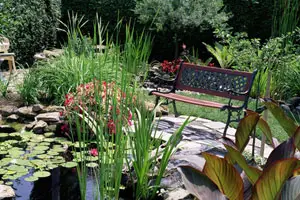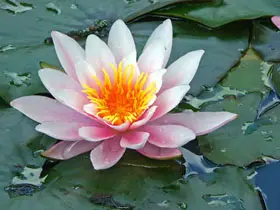Guide to Pond Plants
Part of the fun of having a fish pond is that one gets to create a miniature ecosystem which they can watch grow and thrive. As is the case with any ecosystem, plants are vital to the overall health of the environment. Pond plants provide the same advantages to the pond as plants do to the world at large: they filter the water, they absorb certain materials and add others and they provide shelter for the denizens of the environment.
Aesthetics

The overall look of one's pond will determine to the most significant degree the plants which are appropriate. Modern ponds tend to have a minimal amount of plants. The classic look, of course, is to have very ornate and lovely plants decorating the installation.
For the classic look, remember to include the edges of the pond in one's plans. High, flowering plants at the margins not only make for a beautiful environment, they help to shade the pond from the sun and to keep the water pleasant for the fish. Fish also love hiding in the shadows created by the plants.
Some plants are hardly seen at all. These live entirely below the waterline but they have a very important role to play in the ecosystem. The underwater plants add oxygen to the water just as terrestrial ones add oxygen to the atmosphere. Consider adding these as a way to keep one's pond healthy. They also provide a great place for fish to hide out and relax.
Floating or Anchored
Some garden pond plants will have to be anchored at a specific depth in the water and others will float freely along the surface of the water.
Floating plants add a very beautiful touch. They also serve to lessen the artificial look of liners and to conceal the various hoses and cords needed to properly maintain the pond filter and pump. Some of the more popular floating plants include Duckweed, Water Hyacinth and Water Lettuce. These keep the sun to a minimum in the water which is very important for the health of the fish. Of course, keeping the noonday sun from baking the water also preserves practical elements such as the pond liner.
Some floating pond plants emerge from bulbs. There is hardly a owner who has not, at one time or another, considered adding Lotus or Water Lilies. These beautiful flowers rise to the surface of the water while their roots remain in pots in which the bulbs were originally planted. Locating these flowers on a marginal shelf is the best way to keep them healthy and growing. These pond plants offer shade to the fish just as do the floating plants.
Practical Plants
Of all the plants one can have, the plant no one wants is algae. These colonies of single-celled organisms develop into what's commonly called "pond scum". This smelly, slimy green weed can choke the nutrients out of the water and make the environment entirely unhealthy.

Floating, submerged and marginal plants all fight algae. The principal way in which they do this is by consuming nutrients from the water that would otherwise be used by algae. Simply put, the algae is outclassed by these beautiful additions. In fact, if one were to put no plants in their pond, they would find their algae problems increased several times over what they would be in a pond with a good deal of plant coverage.
Some experts recommend having a great deal of plant life. Recommendations sometimes go as far as to suggest that two-thirds of the water surface be covered with floating vegetation. When the algae tries to move in, it simply finds that there is no room at all.
Plants also consume the waste produced by fish and break it down into harmless materials and, oftentimes, into beneficial nutrients for the water. Maintaining this delicate balance is a very enjoyable part of having a garden or fish pond.
Plant Care
Water plants need the same types of care as do any other. They must be pruned, there needs to be adequate nutrients within their environment to support their life and they need the proper amount of sun to thrive.
Every water plant has slightly different requirements for care. Be sure to follow the recommendations precisely to ensure the best look and healthy growth. Those plants which are kept in basins anchored to the bottom of the pond may need to be pulled up from time to time for care. Underwater plants require little maintenance. Those that live along the margins will need to be maintained just as would any other plant.
Fertilizers
The edges of a pond should always be raised a bit to prevent water from the environment from flowing into the water. Among the most common pollutants found in run-off water is fertilizer. While these fertilizers may be excellent for terrestrial plants, they are absolutely the worst thing for fish. While a healthy population of plants will fight algae, there is nothing that can be done if the water becomes super-fertilized by pollutants from the environment. Make sure that the pond is properly protected from runoff water so that the work done by one's plants is not defeated by environmental pollutants.
Water Circulation
Plants like properly-circulated water just as much as do fish. Having a proper pond pump installed and having good water circulation helps in the fight against algae as much as do the plants themselves. The fresher the water, the healthier one's plants will be and the more beautiful one's pond will become.
Remember to remove plants when the weather turns cold. Many plants can be preserved in an controlled environment over the winter or simply replanted when the weather becomes warm again. Aside from their physical beauty, pond plants pay back the work put into them in many ways!

